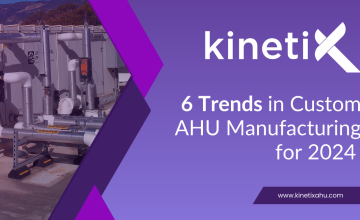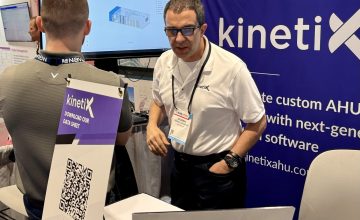Designing a custom AHU (air handling unit) is about more than CFM and other performance metrics. Part of what makes an excellent AHU design is taking into account all the factors that can affect overall lifetime cost. This post will look at three factors that need to be considered during the design phase to keep overall costs under control.
Designing for Ease of AHU Installation
Ease of installation is one of the important parameters that engineers take into account when designing custom AHUs. Although it’s only a one-time cost, it can drive unnecessary expenditures. Here’s what you need to consider:
- The overall configuration, number of over-and-under tunnels, side-by-side tunnels, and overall dimensions
- Overall unit weight and weight distribution (lighter split sections allow for easier installation)
- The number and size of split sections could also have a positive or, if not accounted for, negative impact on the ease of installation of the AHU.
Designing for Ease of AHU Maintenance and Repair
After the performance, maintenance is by far the single most important factor that affects how air handling units are designed and engineered. Choose the right components for the job, and you’ll lower maintenance costs over the life of the AHU.
Here are a few examples of important component choices and their impacts:
- Type of fan: a plenum fan with an AC motor and VFD has more parts and electronics involved (hence more parts to fail), vs. a plug fan (wheel and cone only) with an EC motor, which offers a simpler fan and motor and no VFD and disconnect.
- Motor arrangement: direct drive with the fan wheel coupled to the motor shaft vs. a three-belt drive motor that is complicated and maintenance-prone.
- Motor type selection: AC ODP vs. AC TEFC vs. AC TENV vs. EC, and coil fin material (longer lasting copper fins vs. aluminum fins).
- Heat-exchanger type: energy recovery wheel units tend toward higher maintenance due to the motor, electronics, etc. vs. plate heat exchangers with no real moving parts or electronics.
- Type of filters: standard cartridge vs. longer-lasting extended media filters, which allow for longer periods between filter change-outs.
- Though it might increase initial cost, designing proper pre-filtration will help increase the life expectancy of high-efficiency filters.
- Choosing high-grade construction of elements such as louvers and dampers with aluminum blades and non-corrosive moving parts and accessories (which are proven to require less maintenance and last longer) can also positively impact lifetime cost.
Designing for Ease of AHU Cleaning
Certain design decisions can make it easier or harder to clean an AHU in the long term, which naturally affects maintenance and the equipment’s lifecycle.
Some of the most important factors are:
- Coil depth and fin spacing: the higher the FPI (fins per inch), the more difficult it makes cleaning and maintenance.
- Cabinet materials: specifying more cleanable, higher grade galvanized (G90 or other) stainless steel or aluminum materials vs. lower grade ones (G60 or other) can increase the internal cleanability of the unit.
- Filtration: selecting and positioning appropriate filtration can also have a major impact on how often the air handling unit needs to be cleaned.
- Drain pans: these are designed to contain and evacuate water temporarily. Stainless steel IAQ double sloped (or as needed, triple sloped) drain pans with true-drain positive connections are key to getting coil and possibly humidifier condensate water out of the air handling unit as fast as possible, as standing water is a prime environment for bacterial growth.
- Insulation: selecting proper insulation in the cabinet walls for the perforated liner section is often overlooked. Insulation manufacturers offer anti-microbial materials that deter the growth of organisms in the insulated walls.
- Moisture eliminators: in high humidity environments, moisture/mist eliminators need to be positioned at the air intake to help prevent induced condensation on the inside walls and components of the downstream sections.
Kinetix Air Streamlines, Accelerates, and Cuts Costs of AHU Manufacturing
Custom air handler manufacturing is competitive, and traditional selection software only helps manufacturers do part of the job. Kinetix Air unifies all aspects of custom AHU sales, design, and manufacturing. It automates repetitive and time-consuming parts of the process – cutting your level of effort and reducing risk from errors. Kinetix Air cuts design time by 50% and reduces validation, pricing, submittal, and BOM package time to near zero, saving you more than 20 hours per AHU for an average savings of $200K per year. With a unified solution like the Kinetix Air AHU software, you can design and price an air handling unit that meets any customer specification within a matter of hours and quickly make changes to the model as they come up.
Ready for a demo? Email us or call (818) 293-8240



